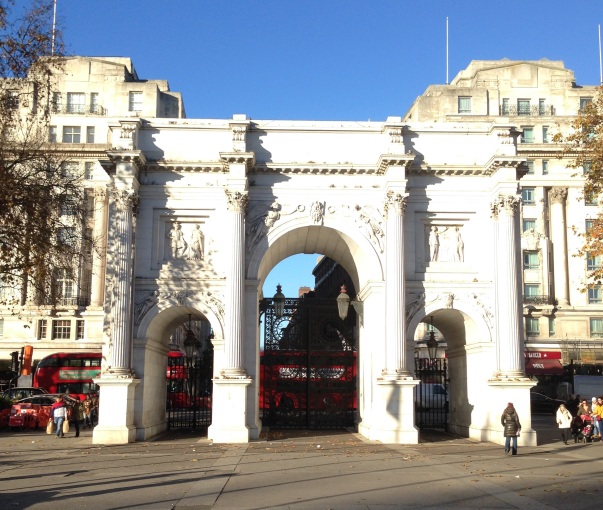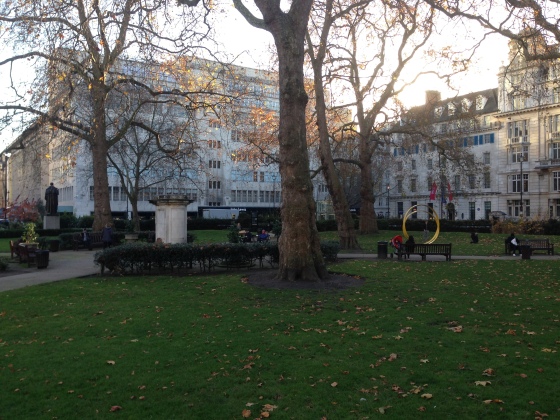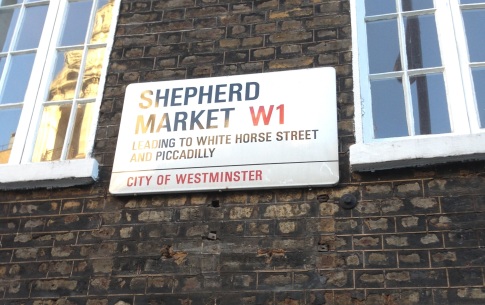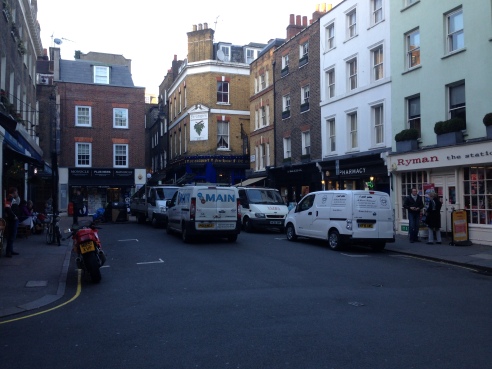It’s that time again as I take another walking journey to explore the wonders of the capital! This week my route begins at Marble Arch takes me along the shopping areas of Oxford Street, Regent Street and New Bond Street via Cavendish Square on to Berkeley Square before finishing in Shepherd Market in Mayfair.

So I start at Marble Arch, a monument located at the junction at Oxford Street, Edgware Road and Park Lane in Westminster. The arch, unsurprisingly is made from Carrara marble, who knew it! It was built in 1825 and designed by our good friend John Nash, who you’ll remember had a significant part to play in our last walking journey, Victoria to Green Park!

The arch’s unique design was based on the Arc de Triomphe du Carrousel in Paris, as well as the Arch of Constantine in Rome (you can see the resemblance in both!).
John Flaxman was picked to create the sculpture though he sadly died before he could complete it, which meant the job was split between three men, J.C.F Rossi, Sir Richard Westmacott and Edward Hodges Baily.
Interesting, the Marble Arch was originally intended to be the ceremonial entrance to Buckingham Palace and it was located there until it moved to its current place in 1851. Its new location in Marble Arch is opposite the Speaker’s Corner, once the site of executions at Tyburn Gallows. The square panels on the north side have three figures representing Wales, England and Scotland with other sculptures to represent Peace and Plenty. Legend has it there are three small rooms in the arch occasionally used as a police station and lookout.
The bronze gates, designed by Samuel Parker, feature the Lion of England and the figure of St George and the Dragon, England’s patron saint. So with its Royal history, you can pass through the gates once graced by many famous royals!
I move from Marble Arch onto my next location, to perhaps one of the most famous shopping areas in the world, Oxford Street! Currently Europe’s busiest shopping street with around half a million daily visitors and an annual turnover of over £1 billion, it runs for approximately 1.2 miles (1.9km). It covers Park Lane, Edgware Road, Bayswater Road, Vere Street, New Bond Street, Bond Street Station, Oxford Circus and to Regent Street.

It was previously known as Tyburn Road, after the River Tyburn which ran to the south of the street located near Uxbridge Road, Worcester Road and Oxford Road. By about 1729, it had become known as Oxford Street. In the 1730s the turnpike trust was established to improve the road’s upkeep which was notorious as a route taken by prisoners on their final journey to Newgate Prison.
By the 18th century the street went under many redevelopments after its surrounding fields were purchased by the Earl of Oxford. In the 1750s buildings began to be erected on the corner of Oxford Street and Davies Street. The street became popular with entertainers including theatres and by the end of the century it was built up from St Giles Circus to Park Lane. It wasn’t until the 19th century that Oxford Street changed from residential to retail with drapers, cobblers and furniture stores beginning to appear. Notable retail occupants were John Lewis in 1864 and Selfridges in 1909.
Today, several retail chains regard their Oxford Street branch as their flagship store, and with nearly 300 stores in the area you can get everything from furniture to fashion, to cooking to computing!
I leave Oxford Street to take a slight detour up to Cavendish Square located at the Eastern end of Wigmore Street. It was first laid out by architect John Prince at the beginning of 1717 for the 2nd Earl of Oxford, with its name deriving from the Earl’s wife, Henrietta Cavendish-Holles. Notable residents in the square were the Duke of Portland, Duke of Chandos, Princess Amelia and the Lane Baronets.

In 1951 a blue plaque was unveiled to commemorate H.H. Asquith, the liberal Prime Minister of the UK from 1908 to 1916, who himself owned and lived at 20 Cavendish Square. The University of Westminster’s founder, Quintin Hogg, also has a plaque there with The Royal College of Nursing’s HQ around the square too.
The bronze statue on the south side of the square, sculptured by Thomas Campebell, is of William George Frederick Cavendish Bentinck (Lord George Bentinck) (1802-1848) who was a Conservative MP for King’s Lynn, Norfolk.
From the pleasant Cavendish Square I take a walk back onto Oxford Street and along to Regent Street. Like its partnering Oxford Street, it features many shops with 7.5 million tourists visiting it every year. Its history dates back as far as the 19th century and was designed by that man again, John Nash! Is there anything in London he didn’t design?! The project of having handcrafted architecture for the shops took 14 years to complete with the name Regent Street coming from Prince Albert Regent who supported its development. In the modern day it now features some of the most recognisable shops in the country, including Liberty, toy store Hamleys and Apple.

My journey from Regent Street takes me onto New Bond Street, the streets just keep coming! One thing you notice about New Bond Street is the brands on offer get pretty high end, from Gucci to Rolex! Built in the 1720s by Sir Thomas Bond, by the 18th century it became a place for more upper-class residents of Mayfair to socialise, hence the many luxury brands that continue to be there today!

From there I take a walk through many short streets onto Berkeley Square in Mayfair. The square, named after John Berkeley, the first Lord of Berkeley of Stratton, acquired the land in 1675 and from there developed his estate. One of the most notable buildings in the square is Landsdowne House, designed by Robert Adam in 1762, and became the venue for many cabinet meetings as well as the home for eight years of Gordon Selfridge, the founder of Selfridges.

Every September to the north of the pump house in the square, is the glamorous Berkeley Square Ball in aid of the Princes Trust.
My journey now takes me to my final location on this week’s walk to a charming small square and piazza of Shepherd Market, tucked away between Piccadilly and Curzon Street in Mayfair.

Mayfair itself is named after the infamous 15 day fair established by James II in the 1680s which took place in Shepherd Market. Developed in 1735-1746 by local architect Edward Shepherd, the market featured path alleys, a duck pond, a two-storey market and theatre. During the 1920s it was an ultrafashionable address for some of London’s most refined inhabitants and is described as ‘The Heart of Mayfair’.

Not a single part of the market is wasted today with places ranging from a barbers to a stationery shop to pubs to restaurants to a pharmacy. The great aspect for me is despite being near a busy road, and amongst the vast buildings of Mayfair, it has still kept its village and histroical feel, and is definitely a hidden gem!
My walking journey has truly taken me through the streets and squares of London! Please share your thoughts and comments on London below, I’d love to hear them! Also remember to follow the blog either on WordPress or via email, and check me out on Twitter and Instagram too! I’ll see you next week for another walking adventure! 🙂
Sources: (not the food sauces)
All photos: London Wlogger © Copyright 2016

How did you get that photo of Oxford St without a trillion people? I enjoyed learning how all the streets were named.
LikeLiked by 2 people
Haha it wasn’t easy, especially as it’s the manic Christmas shopping period! I saw no one in front, so took my opportunity to quickly take it! Glad to hear you liked it 😊
LikeLiked by 2 people
You did well!
LikeLiked by 1 person
Awesome tour, brings back some good memories.
LikeLiked by 1 person
That’s great to hear, Brian! 😊 It’s always nice when you resonate with a certain area and it reminds you of good times ☺️
LikeLike
Sooo Sooo Awesome! Loving it all. Can’t wait for our next Walk. 🙂
LikeLiked by 1 person
Thank you so much! Not long to wait for our next adventures 😊
LikeLiked by 1 person
I looked you up after you followed me. Good stuff. (I still have hundreds more in my Streets of London series)
LikeLiked by 1 person
We look forward to reading about them! 🙂
LikeLiked by 1 person
Nice walk. I see little has changed there in the 20 years since I left. My first job was in Great Malborough Street and I used to do deliveries on foot all over the W1 postcode. Used to love some of those hidden squares around Wigmore Street and Mayfair. Particularly around this time of year when the main shopping steeets were rammed with people, those Mayfair backroads were instantly quieter.
LikeLiked by 1 person
Thanks for sharing your great memories! It’s amazing to think the hectic shopping areas are only a stones throw away from all these secret streets and parks!
LikeLike
Love this post! We walked most of the area when we stayed at Grosvenor House and headed out the door a couple of times. But I had no idea the history of names, etc. Thanks for a great post with so much good info!
LikeLiked by 1 person
Hope you enjoyed your walk when you were here! Thank you so much, I know what you mean, we don’t realise all the fascinating stores behind the landmarks we pass all the time!
LikeLiked by 1 person
Thanks for the follow… your blog is lovely 🙂
LikeLiked by 1 person
Thank you, glad you enjoyed it 😊
LikeLiked by 1 person
Sounds like a great place to get just about anything you want!
LikeLiked by 1 person
Haha yep, you could do all your shopping for the rest of the year there!
LikeLiked by 1 person
MY kind of place!
LikeLike
I missed Mayfair streets
LikeLiked by 1 person